The article was coauthored by Bob Burton (CoalSwarm, Australia), Christine Shearer (CoalSwarm, U.S.), Cynthia Ong (LEAP, Malaysia), Jamie Henn (350.org, U.S.), John Hepburn (Greenpeace, Australia), Joshua Frank (CoalSwarm, U.S.), Justin Guay (Sierra Club, U.S.), Kate Hoshour (International Accountability Project, U.S.), and Mark Wakeham (Environment Victoria, Australia).
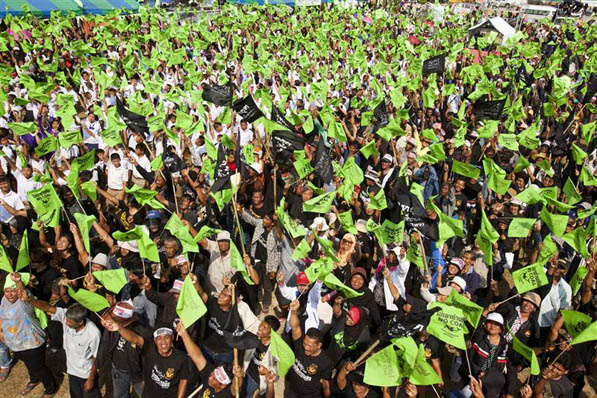 In Thailand, 10,000 people call on their government to quit coal.Photo: Athit Perawongmetha of GreenpeaceIn the United States and Europe, the triple whammy of recession, cheap alternatives, and aggressive anti-coal campaigning has helped halt the expansion of coal use. Since 2004, plans to build more than 150 coal plants in the U.S. have been abandoned. In fact, the U.S. Energy Information Administration (EIA), a government agency that analyzes energy-related statistics, predicts continued stagnation or decline in coal-fired electricity generation in the U.S. and the European Union over the coming decades.
In Thailand, 10,000 people call on their government to quit coal.Photo: Athit Perawongmetha of GreenpeaceIn the United States and Europe, the triple whammy of recession, cheap alternatives, and aggressive anti-coal campaigning has helped halt the expansion of coal use. Since 2004, plans to build more than 150 coal plants in the U.S. have been abandoned. In fact, the U.S. Energy Information Administration (EIA), a government agency that analyzes energy-related statistics, predicts continued stagnation or decline in coal-fired electricity generation in the U.S. and the European Union over the coming decades.
Facing resistance to its longstanding rule in the Organization for Economic Cooperation and Development (OECD) countries, King Coal has redoubled ambitions elsewhere. According to 2010 projections by the EIA, coal consumption in the non-OECD world will increase by 23 quadrillion BTUs between 2007 and 2020. That’s roughly the equivalent of today’s entire U.S. coal-mining and coal-power sector, or approximately a thousand coal-fired generators, each 300 megawatts (MW) in size, spewing toxic chemicals into the environments and lungs of surrounding communities, and an equal number of million-ton-per-year coal mines.
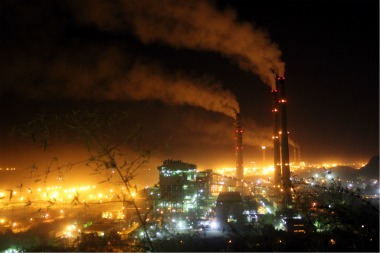 A 2,000-MW coal plant in Madhya Pradesh, India.While China struggles with the enormity of the pollution burden from its world-leading annual coal consumption, it is not the only hotbed of future coal-plant construction. Activists in India, for example, report that regulators gave the green light to at least 173 coal projects during 2010 — nearly one plant every other day. In Southeast Asia, large Chinese utilities such as China Huadian are setting up shop to finance and build a slew of new coal plants. Meanwhile, new coal mines are being proposed in Australia and Indonesia, overwhelmingly for export sales. Countries from Mozambique to Mongolia, which have had little domestic need for coal, are now being hyped as the next big players in the global coal rush.
A 2,000-MW coal plant in Madhya Pradesh, India.While China struggles with the enormity of the pollution burden from its world-leading annual coal consumption, it is not the only hotbed of future coal-plant construction. Activists in India, for example, report that regulators gave the green light to at least 173 coal projects during 2010 — nearly one plant every other day. In Southeast Asia, large Chinese utilities such as China Huadian are setting up shop to finance and build a slew of new coal plants. Meanwhile, new coal mines are being proposed in Australia and Indonesia, overwhelmingly for export sales. Countries from Mozambique to Mongolia, which have had little domestic need for coal, are now being hyped as the next big players in the global coal rush.
In the fertile farming areas that support large rural populations in much of Asia, the new coal boom spells civil conflict, as fields are seized, villages are ordered to pack up and leave, and communities resist. For the U.S. coal movement, the 2,500 people who turned out to protest the Capitol Power Plant was a large number. In India or Bangladesh, marches and demonstrations of more than 10,000 people are not uncommon.
The dominant international narrative focuses on the need to build large numbers of new coal plants across the developing world to spur economic progress. However, the assertion that development can only be achieved through a massive expansion of coal use is being met with increasingly fierce resistance by those asked to bear the most toxic and destructive burdens of this expansion: the people living next to coal projects.
Local populations are resisting private and public-sector pressure to dramatically expand coal-fired power because these projects are not intended for their benefit. While local people face displacement and the destruction of their livelihoods, electricity is often exported to urban centers. Communities are calling for a more sustainable model of energy development that prioritizes access to energy services for all, environmental sustainability, and human health. Their efforts to halt coal-plant construction have placed them front and center in the struggle over energy and development in the 21st century.
In the past, most communities struggling to take on ill-conceived projects have done so largely on their own, but that’s starting to change. International coalitions are beginning to develop to bring publicity and support to front-line efforts. Here are a dozen places around the world where people are uniting to halt coal projects, increasingly with international support.
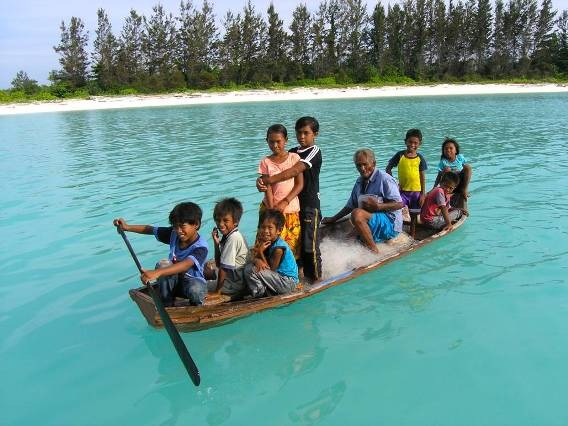 South of the proposed site of coal plant in Malaysia, coastal communities depend on fishing for their livelihoods.Photo: Helen Brunt.1. Sabah, Malaysia
South of the proposed site of coal plant in Malaysia, coastal communities depend on fishing for their livelihoods.Photo: Helen Brunt.1. Sabah, Malaysia
In April, 1,500 people convened on a beach in Malaysia to savor a victory that had been judged impossible just two years earlier: the defeat of a 300-MW coal plant in the Malaysian state of Sabah, located on the northeast side of the island of Borneo. Celebrations were also underway 7,500 miles away, in California, among a group of activists who had helped draw international publicity to the issue — including a Time magazine article entitled “A Coal Plant in Paradise.” The Malaysian group LEAP (Land Empowerment Animals People) helped forge the coalition of Malaysian NGOs, grassroots communities, and citizen movements, and generate support from the U.S. and other parts of the world. Along with LEAP, the coalition included World Wildlife Fund for Malaysia, Malaysian Nature Society, Partners of Community Organizations Trust, and the Sabah Environmental Protection Association. Among those providing overseas support were 350.org and Mongabay, which worked to publicize the project, and Daniel Kammen of UC-Berkeley and the World Bank, who coordinated a comprehensive energy analysis proposing clean energy alternatives to coal-fired power in Sabah.
 Bangladeshis march en masse against coal.Photo: Anha F. Khan2. Phulbari, Bangladesh
Bangladeshis march en masse against coal.Photo: Anha F. Khan2. Phulbari, Bangladesh
Bangladesh’s high population density (more than 164 million people in a country the size of Iowa) and rich agricultural land make coal mining a destructive proposition. In the township of Phulbari, as many as 220,000 people would be displaced by a proposed 15-million-ton-per-year coal mine and a 500-MW coal plant. Community opposition reached a crescendo in 2006, when paramilitary forces fired on a protest rally of as many as 70,000 people, killing three people and injuring 200. In the wake of these deaths, nationwide protests and strikes closed down the country for four days. They were brought to an end only when the government signed an agreement to ban open-pit mining and permanently expel the project’s London-based financier, Asia Energy Corporation (now Global Coal Management Resources Plc or GCM). Although demonstrators burned down the company’s project information office and its personnel were forced to flee the country, GCM has since returned, with backing from New York-based financier Christian Leone and U.S Ambassador James Moriarty. During recent demonstrations, the Bangladeshi government has deployed its Rapid Action Battalion, notorious for torture and for the deaths of persons in its custody. The repression has failed. In October 2010, tens of thousands of people joined a 250-mile march from the capital of Dhaka to the town of Phulbari. The coalition opposing the mine has grown to include groups from across the spectrum of Bangladesh’s civil society, as well as international groups. The San Francisco-based International Accountability Project is involved in coordinating overseas support and outreach.
3. Andhra Pradesh, India
This coastal state of eastern India is experiencing a coal-plant construction boom, including the 4,000-MW Krishnapatnam Ultra Mega Power Project, one of nine such massive projects in planning or under construction across the country. (By comparison, the largest coal plant in the United States, Plant Scherer in Georgia, is 3,564 MW.) Residents have resisted the siting of large plants in densely populated and ecologically sensitive agricultural districts. The 2,640-MW Sompeta plant proposed by Nagarjuna Construction Company and the 2,640-MW Bhavanapadu plant proposed by East Coast Energy have both provoked large nonviolent protests that have ended in police attacks, including four deaths of local residents. Following coverage of the police action on Indian television, investigations revealed a pattern of “crony capitalism” among the permitting agencies and corporate sponsors. As of May 2011, the Sompeta plant had been cancelled and the Bhavanapadu plant had been placed on hold by officials, with corruption investigations continuing. However, the sponsor of Sompeta, Nagarjuna Construction, is now initiating a 1,320-MW plant elsewhere in Andhra Pradesh.
4. Dawei, Burma
In Dawei, on the beautiful southern peninsula coast of Burma, Italian-Thai Development Plc signed a deal in Nov. 2010 to build a 4,000-to-6,000-MW coal plant, the largest in Southeast Asia and possibly the world. Within weeks of the signing, 19 villages had received orders to move. Dawei is 10 miles from Maungmagan, a scenic beach and rich fishing district. Burma is an authoritarian state where land displacements occur by edict and activism carries heavy risks. Yet despite the repression, grassroots action has been effective, such as in 2001 when villagers in the town of Tachilek organized protests and blocked trucks delivering construction equipment, forcing the cancellation [PDF] of Golden Triangle’s coal plant.
5. Nakhon Si Thammarat Province, Thailand
On Feb. 24, 2011, 10,000 people formed a human chain in this province in Thailand to protest a coal-fired power plant planned by Electricity Generating Authority of Thailand. This protest followed a decade of organizing and protesting by the Eastern People’s Network focusing on the coastal Thai town of Rayong. The protests delayed operations of the massive Map Ta Phut industrial park, including a 1,400-MW coal plant.
6. Konkan Coast of Maharashtra, India
Home to 112 million people, this state in western India is building a concentration of large coal plants on a tiny sliver of land south of Mumbai known as the Konkan Coast (dubbed “the California of Maharashtra”). As much as 35,000 to 50,000 MW of generating capacity is on the drawing board. Concerned by the pollution and displacement entailed by the massive proposals, farmers have targeted some of the largest projects. One of these is the 4,000-MW Girye Ultra Mega Power Project, which prompted mango farmers and others to stage marches, hunger strikes, and other nonviolent actions. They successfully forced the project to seek a new location [PDF] as protests barred the government from acquiring the needed land. Other projects facing local resistance include the 1,000-MW Mauda power station and the 1,200-to-1,800-MW Shahapur Thermal Power Project.
7. Orissa, India
In this state on the eastern coast of India, the scale of coal-plant development is staggering. As much as 58,000 MW of projects are in the works, including three 1,800-MW coal plants under development by KSK Energy Ventures and the 4,000-MW Sundargarh Ultra Mega Power Project being planned by National Thermal Power Corporation. Ranjan Panda of Water Initiatives Odisha says that this level of coal development would require a minimum of 2,297 million cubic meters of water per year, enough to meet the domestic water requirement of close to 210 million people. In March, activists from across India converged on Orissa for a national conclave to plan a response to the coal boom, as well as the related issues of energy use and climate change. The mobilization includes the National Alliance for People’s Movements, Focus Odisha, and numerous other groups.
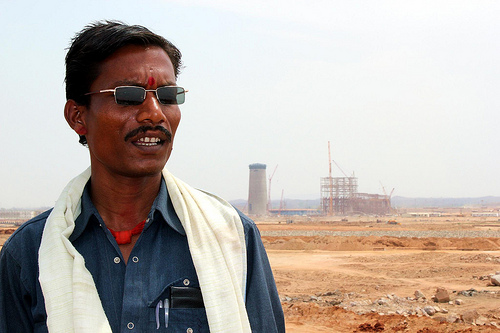 This man says his friend attempted to protest the Sasan coal plant; his house was bulldozed and he hasn’t been seen since.Photo: Sierra Club8. Madhya Pradesh, India
This man says his friend attempted to protest the Sasan coal plant; his house was bulldozed and he hasn’t been seen since.Photo: Sierra Club8. Madhya Pradesh, India
Since 1977, when the World Bank financed the first coal-fired plant in the region, the Singrauli district of this state in central India has been notorious for roughshod development and population displacement. Now more massive coal plants are being built or planned. They include the 3,960-MW Chitrangi Power Project, the 3,960-MW Sasan Ultra Mega Power Project (which is getting nearly $1 billion in financing from the U.S. Export-Import Bank), the 1,200-MW Mahan Super Thermal Power Project, the 750-MW Hindalco Captive Power Project, the 1,320-MW Nigrie Thermal Power Project, the 2,690-MW DB Power (M.P.) Limited Project, and the Vindhyachal Stage-4 Project, which will add an additional 1,000 MW to an existing 3,260-MW power station. The concentration of power generation in an agricultural area has left local communities reeling. The Sasan Ultra Mega Power Project, for example, has displaced 6,000 people. One man is benefiting: Mukesh Ambani, the controlling owner of India-based Reliance Power, whose reported net worth of $27 billion makes him one of the world’s five richest individuals.
9. Queensland and New South Wales, Australia
On a tonnage basis, Australia already leads the world in coal exports, and that lead may widen significantly if several massive mines are allowed to move forward in the eastern coal-mining states of Queensland and New South Wales. Australia is undergoing a “coal rush” with more than 100 new projects or expansions in planning, including a number of mega-projects such as the 60-million-ton-per-year Carmichael mine by India-based Adani Group and the 30-million-ton-per-year China First mine proposed by billionaire Clive Palmer. Farmers and ranchers are fighting back with a concerted effort to protect rich agricultural lands and precious water resources from mining operations. Environmentalists are challenging numerous projects in the courts and have staged colorful direct action, such as a creative blockade of the port of Newcastle.
10. Victoria, Australia
While the low-quality coal in this state in southeastern Australia is not suitable for export, it provides 91 percent of the fuel used for power generation in Victoria itself. Last year, Environment Victoria and other groups came close to shutting down the aging Hazelwood Power Station, the second largest source of carbon pollution in the country, after commitments by Victoria Premier John Brumby to begin a staged retirement of the plant. The narrow victory of the Liberal-National party in Nov. 2010 dashed hopes for near-term action on the plant from the state government, though the federal government is now exploring linking closure of the plant to the price on carbon. Activist attention has also shifted toward preventing the construction of the proposed Dual Gas Power Station, which would burn a combination of brown coal and natural gas.
11. Colombia
One of the oldest examples of citizens working across national boundaries on coal issues is the coalition of human rights and labor organizations that has brought attention to the massive mines in Colombia, such as the 35-by-5-mile Cerrejón coal mine, operated by Cerrejón Coal Company, and the mines operated by Drummond. The expansion of these mines has been marked by paramilitary violence, high numbers of deaths in mining accidents, and displacement of entire communities, including Tabaco, a 700-person Afro-Colombian village that was razed in 2001. Witness for Peace has brought members of Kentuckians for the Commonwealth to visit the mines, as well as people who live near the Salem Power Station in Massachusetts, which uses coal from Colombia.
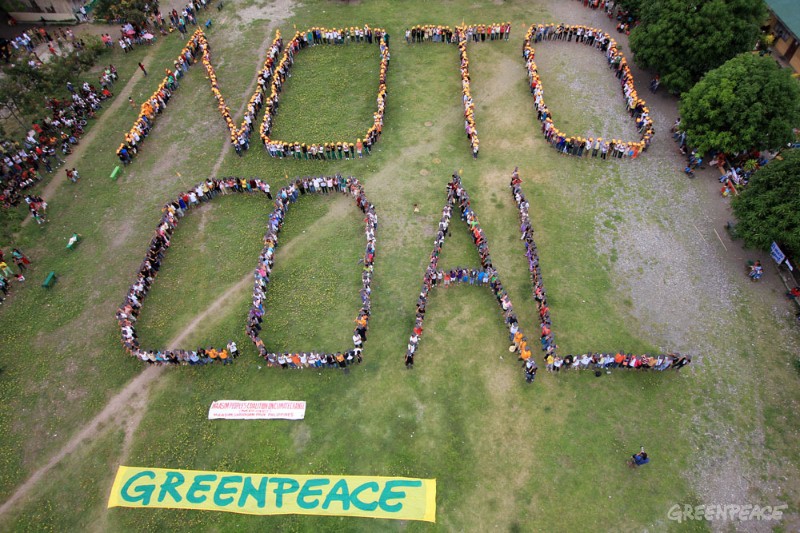 Eight-hundred people spell out their message.Photo: Greenpeace12. Sarangani Province, the Philippines
Eight-hundred people spell out their message.Photo: Greenpeace12. Sarangani Province, the Philippines
In the Philippines, grassroots protests against new coal plants and open-pit coal mining have taken place across the country. In the coastal town of Maasim on the southern island of Mindanao, local fishermen organized a flotilla of outrigger boats in Nov. 2010 to protest the proposed 200-MW Kamanga power station, while 800 people formed a human banner spelling out “No to Coal” on the grounds of a local elementary school. Supporters of the efforts included the local Catholic church, leaders of indigenous groups, foreign divers, and Greenpeace. At a separate demonstration, students at Mindanao State University dressed as Na’vi from the film Avatar marched on the fenced property of the proposed plant site. In April 2011, South Cotabato province, also on Mindanao, adopted an ordinance that would ban open pit mining in the region.
As grassroots resistance grows in countries around the globe, a nascent, interconnected, worldwide anti-coal movement is emerging. In an increasingly globalized world, local campaigns can quickly reach a global audience and tap into previously unimagined support networks. While the participants in this new movement are diverse, some of the patterns are becoming clear: sustained and passionate grassroots activism is challenging the idea that fossil fuels are the only option. Many governments have backtracked or shelved plans in response to political pressure or legal actions. Some banks, investors, and even energy companies are growing increasingly wary of further supporting coal.
But it’s still too early to write the obituary for King Coal. The industry is now attempting to wrap itself in the cloak of “development,” justifying dirty energy projects in the name of providing energy access for some of the world’s most economically poor countries. While many coal projects have encountered strong opposition, too many others are proceeding without challenge.
Yet those who are pushing coal projects are increasingly being seen in much the same light as tobacco-industry executives. Like tobacco, coal insinuated its way into our lives delivering a cheap, short-term energy high, but leaving a bitter long-term aftertaste — in the case of coal, ruined rivers and lands, lives wrecked and cut short, abandoned communities, and an increasingly polluted and potentially unlivable atmosphere.
We need clean energy alternatives, not the continuation of dirty energy that destroys people’s health, livelihoods, and resources. Will you join the growing global movement to move away from coal?



